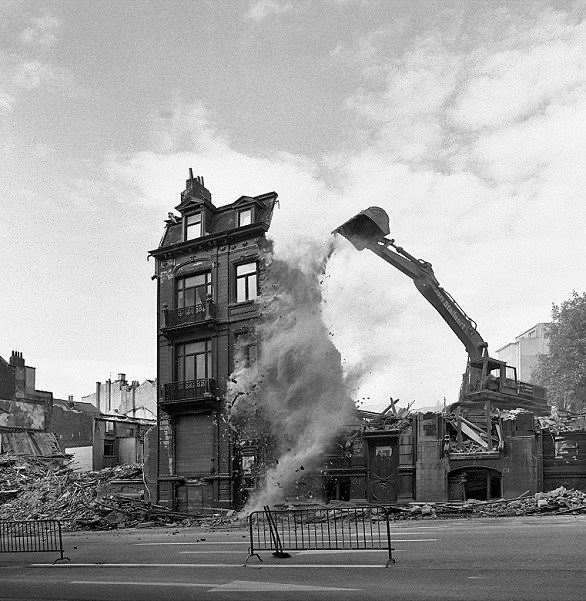On April 25 last year, Alicja Gescinka wrote an opinion piece for The Brussels Times about the process of Brusselization, the destruction of buildings of historically important architecture, to be replaced by modern tower blocks.
As her piece indicates, the process began after the end of the Second World War, and it was certainly in evidence when I arrived in Brussels in 1974.
While Gescinka is especially interested in the destruction of older buildings, in fact another aspect of this process also needs to be emphasised, since it is a continuing process: the construction of ultra-modern high-rise tower blocks, ostensibly to accommodate the growing need for offices and housing.
When I first arrived in Brussels in 1974, such a construction was taking place in Schaerbeek: the Brusilia tower on the edge of Park Josaphat. Original plans apparently intended the building to be extended sideways after a few years to the full height of what is currently in place; instead, a much lower addition was eventually constructed.
In 1974, rumours abounded concerning the political decisions to rubber stamp such construction, which were seen to be to the economic benefit of the construction industry as much as anything else.
In St. Josse, where I ended up living (in a unique, beautiful old house hidden away in the side streets), a similar building had been erected in 1967, the Residence Pacifique, a 75 m, 25-story block in rue Willems. Approval for the project had been given by Guy Cudell, the socialist mayor of St. Josse, who, it has been said, needed the funds for his financially-impoverished commune.
In 2007, the French-language newspaper La Derniere Heure, published a series of articles about several suicides committed by residents who leapt from the building. These events confirm what Gescinka contends about the emotional effects of the spaces in which we live.
Four years ago I moved from St. Josse to Schaerbeek, another commune in which fascinating architecture abounds. As it happens I ended up in the neighbourhood surrounding the site of the RTBF and VRT radio headquarters, a site visually distinctive because of the now iconic RTBF tower that was constructed not long after I first came to Brussels.
And now this site is the object of new planning, aimed at completely transforming it into a “Mediapark”. A PAD (Plan Directeur d’Amenagement) for this project has had a first reading, and following the recent Brussels regional elections, its second reading by the government will proceed.
The Mediapark project is enormous. As well as reconstructing headquarters for the RTBF and the VRT, a number of new buildings are proposed, potentially to accommodate media-oriented businesses, a training centre, even a cinema … and, housing to accommodate up to 2,000 residents.
The iconic RTBF tower will not be destroyed; but it may be at least partly hidden by a 15-story apartment block currently planned to be constructed near the edge of the site, with the destruction of a “green” curtain of trees and bushes that currently encircles the existing buildings.
Recent PADs for other parts of Brussels have started to provoke concern about various proposed tower blocks – 14 very tall buildings have been proposed for the Rue de la Loi, supported by the Region’s Secretary for Urbanism, Pascal Smet, who has openly expressed a desire for more tall buildings, as a way, according to him, to make Brussels more vibrant, more up-to-date.
Apparently the 15-floor plans reflect the cost (to the builders); anything beyond seven stories becomes more expensive to build because of fire regulations, per level, until 15 floors are included in the plan – the income from the additional 8 stories compensates for the additional cost.
This is for the benefit of the Brussels population? Or the builders? Apartment buildings opposite the Mediapark site are all limited to seven stories, and despite some years of reconstruction following the destruction of the viaduct that harboured asbestos, the boulevard remains an interesting and livable urban area. Enough is enough!
The local objections to the Mediapark PAD are not limited to the proposed size of buildings. Green spaces on the site, offering biodiversity and a way to maintain good air quality, are designated for destruction. Parking and local traffic issues are significant.
For over a year now, a local neighbourhood committee, the Comite du Mediapark, has been questioning the plans for the Mediapark. Similar neighbourhood committees have formed in reaction to PADs proposed for other neighbourhoods in Brussels, including a committee currently actively concerned about the 14 tower blocks proposed for the Rue de la Loi.
Some successes (for example, rejection of the PAD proposed in Schaerbeek opposite the Parc Josaphat) are heartening.
What remains worrying is that, while claiming to be listening to the neighbourhood concerns, the Region doesn’t really permit public access to decision-making; transparency is not the name of the game.
Many aspects of the plans remain obscure, with the natural suspicion that yet another example of Brusselisation is underway… that the Region may be supporting new construction to the advantage of the construction industry, rather than taking into account the varied needs of existing local residents.
By Malinda Coleman


